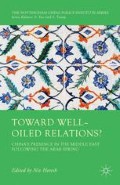Abstract
The last two decades have witnessed China’s expanding economic footprint in the Middle East. China is currently the foremost trading partner and largest oil importer of several Middle Eastern countries. With the implementation of Xi Jinping’s “One Belt, One Road” in 2015,1 China looks set to further strengthen its economic and diplomatic influence in this region.
Access this chapter
Tax calculation will be finalised at checkout
Purchases are for personal use only
Preview
Unable to display preview. Download preview PDF.
Notes
Steve A. Yetiv and Chunlong Lu, “China, Global Energy, and the Middle East, ” The Middle East Journal, Vol. 61, No. 2, 2007, p. 201.
Jon B. Alterman, John W. Garver, The Vital Triangle: China, The United States, and the Middle East (Washington: Centre for Strategic and International Studies), 2008, p. 4.
Henry Kissinger, World Order (London: Allen Lane), 2014, p. 144.
Nozar Alaolmolki, Life after the Soviet Union: The Newly Independent Republics of Transcaucus and Central Asia (New York: State University of New York Press), 2001, p. 67.
Dietrich Jung and Wolfango Piccoli, Turkey at the Crossroads: Ottoman Legacies and a Greater Middle East (London: Zed Books), 2001, p. 180.
Zeyno Baran, Torn Country: Turkey between Secularism and Islamism (Stanford: Hoover Institution Press Publication), 2010, p. 117.
Behlül Özkan, “Turkey, Davutoglu and the Idea of Pan-Islamism,” Survival , Vol.56, No.4, 2014, pp. 119–140.
Henry Kissinger, World Order (London: Allen Lane), 2014, p. 133.
Steve A. Yetiv and Chunlong Lu, “China, Global Energy, and the Middle East, ” The Middle East Journal, Vol. 61, No. 2, 2007, p. 199.
Henry Kissinger, World Order (London: Allen Lane), 2014, p. 159.
Muhamad S. Olimat, China and the Middle East: From Silk Road to Arab Spring (London: Routledge), 2012, p. 80.
Muhamad S. Olimat, China and the Middle East: From Silk Road to Arab Spring (London: Routledge), 2012, p. 72.
Geoffrey Kemp, The East Moves West: India, China, and Asia’s Growing Presence in the Middle East (Washington: Brookings Institution Press), 2012, p. 78.
Editor information
Editors and Affiliations
Copyright information
© 2016 Niv Horesh and Ruike Xu
About this chapter
Cite this chapter
Horesh, N., Xu, R. (2016). Conclusion: China’s Growing Presence in the Middle East. In: Horesh, N. (eds) Toward Well-Oiled Relations?. The Nottingham China Policy Institute Series. Palgrave Macmillan, London. https://doi.org/10.1057/9781137539793_14
Download citation
DOI: https://doi.org/10.1057/9781137539793_14
Publisher Name: Palgrave Macmillan, London
Print ISBN: 978-1-349-57921-1
Online ISBN: 978-1-137-53979-3
eBook Packages: Economics and FinanceEconomics and Finance (R0)

